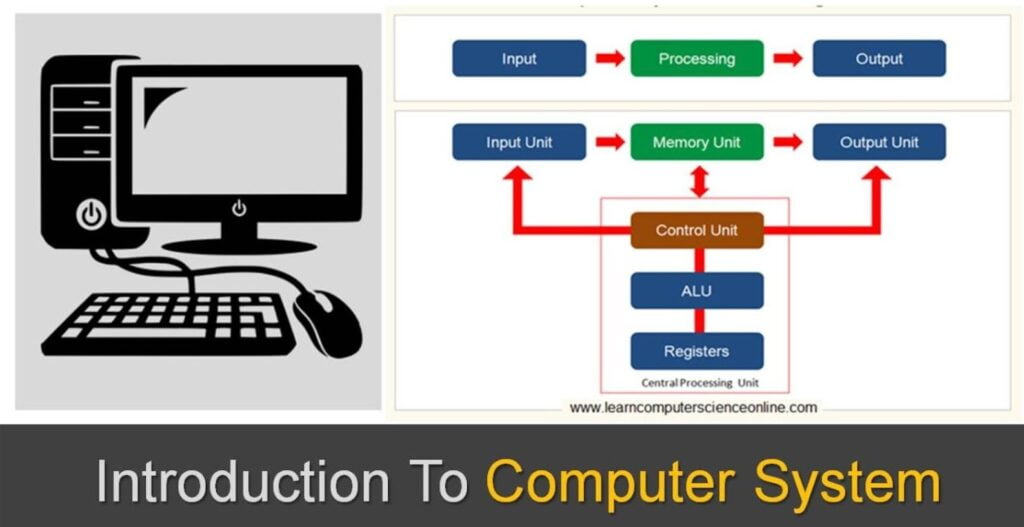Introduction to Computer notes as per latest syllabus of NIELIT Course on Computer Concepts (CCC) online exam. Chapter 1 includes Computer and Latest IT Gadgets, Basics of Hardware and Software and Mobile Apps.
Introduction to Computer : Short Notes
Introduction:
- Computers are electronic devices that process and store data, perform calculations, and execute tasks based on instructions.
- They have become an integral part of modern life, influencing various fields such as communication, education, business, and entertainment.
Computer and Latest IT Gadgets
- Computers and IT gadgets have become integral parts of our daily lives.
- Evolution of Computers & its applications
- Computers have evolved significantly over the years in terms of size, speed, and capabilities.
- Early computers were large and used vacuum tubes, while modern computers are small, fast, and use microchips.
- Applications of computers include data processing, scientific research, communication, entertainment, etc.
- IT gadgets and their applications
- IT gadgets refer to portable electronic devices that utilize computer technology.
- Examples of IT gadgets include smartphones, tablets, laptops, smartwatches, etc.
- IT gadgets are used for various purposes such as communication, productivity, entertainment, health monitoring, etc.
Basics of Hardware and Software
- Hardware refers to the physical components of a computer system.
- Software refers to the programs and instructions that control the hardware and enable it to perform tasks.
Hardware
- Central Processing Unit (CPU)
- The CPU is the “brain” of the computer and carries out instructions.
- It performs arithmetic and logical operations and controls the execution of software programs.
- Input devices
- Input devices are used to enter data and instructions into the computer.
- Examples of input devices include keyboards, mice, touchscreens, scanners, etc.
- Output devices
- Output devices display or present data processed by the computer.
- Examples of output devices include monitors, printers, speakers, etc.
- Computer Memory & storage
- Computer memory is used to store data and instructions that are currently being processed.
- Primary memory (RAM) stores data temporarily, while secondary memory (hard drives, solid-state drives) stores data permanently.
Software
- Software consists of programs and instructions that tell the hardware what to do.
- Application Software
- Application software is designed for specific tasks or applications.
- Examples include word processors, web browsers, photo editing software, games, etc.
- Systems Software
- Systems software manages and controls the computer hardware.
- Examples include operating systems (Windows, macOS, Linux), device drivers, etc.
- Utility Software
- Utility software provides additional functionality and tools to enhance computer performance.
- Examples include antivirus software, disk cleanup tools, file compression utilities, etc.
- Open source and Proprietary Software
- Open source software is distributed with its source code, allowing users to modify and distribute it freely.
- Proprietary software is copyrighted and its source code is not available for modification.
- Examples of open source software include Linux operating system and the Firefox web browser.
- Examples of proprietary software include Microsoft Office and Adobe Photoshop.
Mobile Apps
- Mobile apps are software applications designed to run on mobile devices.
- They are developed for specific operating systems, such as Android or iOS.
- Mobile apps serve various purposes, such as communication, entertainment, productivity, social networking, etc.
These notes provide an overview of Chapter 1, covering the introduction to computers, the evolution of computers and IT gadgets, basics of hardware and software, and the different types of software, including mobile apps.
Chapter wise Notes for CCC Online Test
- Introduction to Operating System Notes for CCC
- Word Processing Notes for NIELIT CCC Exam
- Spreadsheet Notes for CCC Test
- Presentation Notes including LibreOffice Impress for CCC
- Internet and WWW (Networking) Notes for CCC Exam
- Notes on E-mail, Social Networking, and e-Governance Services
- Digital Financial Tools and Applications Notes for NIELIT CCC Test
- Future Skills & Cyber Security Notes for CCC Online Test
